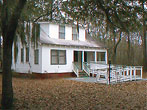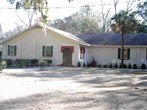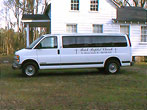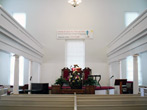A Historic Landmark
 Brick Baptist Church’s heritage is woven into the rich tapestry of African American culture and history of the South Carolina Sea Islands. Built by slaves in 1855, Brick Baptist Church is the oldest church on St. Helena Island. The two-story building is constructed of mortar and bricks built around a spacious sanctuary. An open balcony was used for the slaves who stood during the services, always out of view of the white plantation owners who sat on the lower level.
Brick Baptist Church’s heritage is woven into the rich tapestry of African American culture and history of the South Carolina Sea Islands. Built by slaves in 1855, Brick Baptist Church is the oldest church on St. Helena Island. The two-story building is constructed of mortar and bricks built around a spacious sanctuary. An open balcony was used for the slaves who stood during the services, always out of view of the white plantation owners who sat on the lower level.
In 1861, after the day of “big gun shoot”, the fall of Port Royal and the insurgence of the Yankees signaled the end of a brutal era in American history—the end of the Civil War and slavery. Later when the government sold abandoned plantations and land holdings to freed slaves, Brick Baptist Church was turned over to 8000 former slaves as their place of worship. There were more than 1000 members, with more being converted and baptized every three months.
The legacy of Brick Baptist Church is closely connected to historical Penn School, established as one of the first schools for freed slaves. In October 1862, Laura M. Towne and Ellen Murray, Penn School co-founders, opened their school at The Oaks Plantation with nine students, and later moved to Brick Baptist Church when enrollment increased to 132 students. Charlotte Forten, the first African-American teacher, taught at Penn School until 1864.
For more than a century and a half, Brick Baptist Church has endured and prospered through the word of God. The church has also served as a catalyst for change and a cornerstone of religious and family values. Brick Baptist Church is focused on becoming a teaching church, offering religious instruction for youth, establishing foreign missions, building community outreach, increasing membership, designing a scripturally-based vision, and endeavoring to spread the gospel throughout the world.
Celebrating Our History
![]() 1855
1855
Brick Baptist Church, the first church on St. Helena Island, was built by slaves for white plantation owners.
![]() 1861
1861
8000 former slaves assumed control of Brick Baptist Church after the Battle of Port Royal “Big gun shoot.”
![]() 1862
1862
Laura Towne and Ellen Murray opened Penn School in Brick Church with 132 students. Charlotte Forten, the first African-American teacher, taught until 1864.
![]() 1862-1884
1862-1884
Brick, the “Mother Church,” gave birth to Adam St. Baptist, First African Baptist and Ebenezer Baptist Churches.
![]() 1883
1883
The church’s first Sunday school was established.
![]() 1926
1926
The church obtained a $2000 loan to buy land and build a parsonage.

![]() 1954
1954
Rev. J. Edwin Johnson founded Faith Memorial Church and 125 members left Brick Church.
![]() 1971
1971
Under Rev. Marion Newton’s pastorate, the Baptist Church of Beaufort turned over the deed to the Brick Baptist Church property to the members. Rev. Newton was also instrumental in establishing the St. Helena Island Memorial Garden (cemetery) under the ownership of Brick Baptist Church.
![]() 1974
1974
Brick Baptist Church was designated as part of the Penn National Historic Landmark district.
![]() 1978
1978
Rev. Ervin Greene served for 21 years. The church grew and a variety of ministries were established, such as the Youth Retreat, the Silvers’ Banquet, foreign missions, and fellowship with St. Helena Baptist Church.
![]() 1984
1984
The Clarence Johnson Fellowship Hall and educational building was constructed at a cost of $180,000.

![]() 1999
1999
Rev. Dr. Sally LaPoint was the first woman to be ordained at Brick Baptist Church and served as Interim Pastor for seventeen months.
![]() 2001
2001
Rev. Abraham Murray was installed as the first residential pastor in 40 years. He activated the Men’s Ministry and re-organized the education and outreach ministries.
![]() 2002
2002
The church purchased its first vehicle and began the Transportation Ministry.

![]() 2004
2004
The interior of the historic sanctuary of Brick Church was refurbished. Rev. Murray published a new member's handbook and initiated new member classes.

![]() 2005
2005
The Fellowship Hall was remodeled to include new fixtures, appliances, carpeting, and painting. The church upgraded its technology and established its first web site.
 Home Page
Home Page